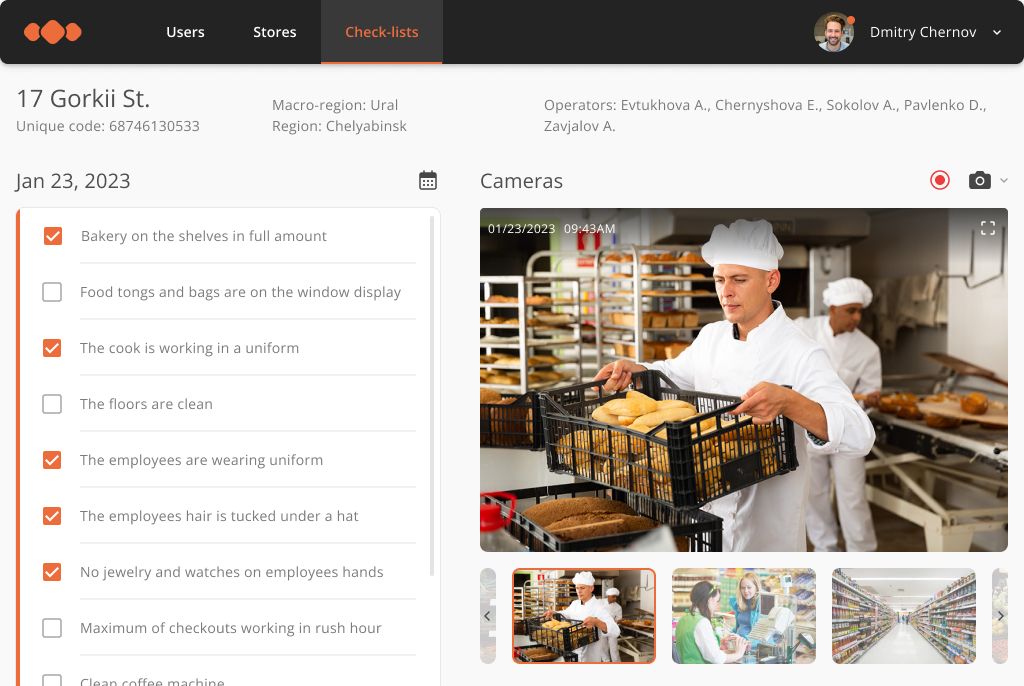Customer
Mag Development, develops IT-solutions for one of Russia’s largest food holding
Integration of different types of videos, access roles, and control of standards according to the set check-lists
Mag Development, develops IT-solutions for one of Russia’s largest food holding
500+
stores
Each retail store chain has its set of quality standards for ensuring that the goods are laid out correctly on the shelves, the employees look good, and not many customers are waiting at the checkout. This is needed to keep customers happy, prevent them from leaving and meet partners obligations to suppliers. These processes are expensive for businesses because they require a separate staff or the so-called ‘on-site’ controllers. This work can be done remotely and across a group of stores at the same time, which may save money and reduce the impact of the human factor.
Our team developed a video analytics platform that can centralize all the video insights from hundreds of supermarkets across the country. Thanks to the service, it is now possible to simultaneously monitor large groups of stores with one operator. It made it easier to control how standards are implemented, improve the quality of service, and employee discipline.
Video streams were taken from equipment that had already been set up in the stores by the security services. Each camera only captures a small area of the hall, which can include one or several zones for visual control, such as shelves, aisles, ready-made food or baking stalls, checkouts, and all the employees who work there. The administrator of the web-system assigns zones to each camera.
The project was complicated by fragmented views, camera generations, video formats, and channels of data transmission. The video format included AVI, MPEG, and BMP. We had to use HTTP to connect to the servers, and sometimes we had to use special protocols. To connect all the streams in one place, Rubius developers designed separate adapters for each way of connecting.
To allow the operator to switch between stores and monitor the past hours, we considered storing the images at the definite server within the interval of 15 minutes. Thus, the employees were able to access the dynamics of observation within a day. The system automatically deleted the images after 24 hours. Besides that, at the request of the customer, the portal uploads and plays a video fragment from the selected time period.
There were two basic roles included in the project, administrator and operator. The main role of the first one is to adjust the system work, while the second one is to control the work of the stores.
The operator can view videos and photos in the system, fill out check-lists and generate reports on compliance with standards for individual stores, territories, parameters, periods and zones. For example, you can find out whether a chef always puts on a cap in a particular store in a particular macro-region.
Our team has come up with a few different types of display: a gallery, a list of stores or store cards. In addition, we incorporated the possibility of corporate authorization through the Active Directory server.
Check-lists can be customized by choosing control options for different stores and groups. The base sheet contains 10 blocks, or ‘zones’ to check, such as the bread shelf, vegetables and fruits, promotional activities, display of goods, cleanliness of floors and look of employees. The operator can easily check if the cashier’s hair is tucked away, if employees are wearing watches and jewelry, if the best offers are in place, and if there is rubbish next to the coffee machine.

One employee now controls up to 50 stores, access to surveillance is open 24/7, the company has reduced the cost of personnel, transport, and communications. All video cameras are gathered into a network with a single access point for administration and work.
Tell us about your requirements and we’ll get back with a possible technical solution